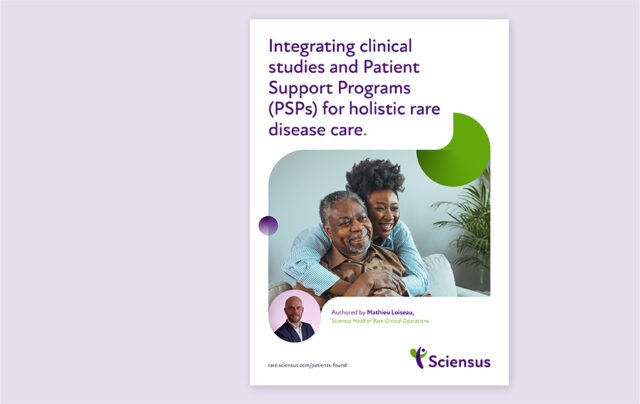
Five key steps to success: Maximising patient engagement in oncology
Launching a new oncology drug is a complex undertaking. In this highly specialised and often emotionally charged field, brand and marketing professionals face a unique set of challenges. As well as addressing the clinical aspects of the drug, they must also develop effective patient engagement strategies to maximise adherence, optimise outcomes and create a meaningful value proposition.
In this article, we explore the importance of patient engagement and share five key steps to successfully integrating engagement into your oncology brand launch.
Why patient engagement matters in oncology
Effective patient engagement in oncology is critical to improving treatment outcomes. Higher engagement levels ensure patients can adhere to oncology’s typically complex treatment regimes. Engagement also supports the early reporting of side effects, improving our chances of helping patients manage them successfully and maintain a higher quality of life.
For pharma companies, increased therapy persistence can lead to better evidence of the drug’s real-world effectiveness, which ultimately strengthens its value proposition for payers and clinicians, and enhances brand reputation. From a healthcare system perspective, patient engagement helps reduce emergency admissions, supports efficient resource utilisation, improves care coordination and creates a better patient journey.
Clearly then, to ensure a successful oncology brand launch, we must consider how to maximise patient engagement. Here are five key steps that can help pharma companies navigate the challenges and achieve success.

1. Understand the patient journey and the wider ecosystem
The first step in ensuring a successful oncology drug brand launch is to build a comprehensive understanding of the patient journey. Oncology patients face so many challenges, from navigating complex treatment regimens to managing the psychological and emotional burden their diagnosis brings.
To create truly effective patient engagement strategies, pharma companies must map the entire patient journey, identifying key touchpoints and decisions that can influence patient behaviour.
Key considerations:
- Mapping the journey: Start by mapping out the full patient journey, from diagnosis to post-treatment care. This should include all interactions with healthcare providers, support services, caregivers and advocacy groups.
- Identifying barriers: Determine the barriers patients face at different stages of the journey. This could include the complex nature of their treatment, the burden of side effects, financial concerns or emotional strain.
- Engagement points: Identify key moments when patients may disengage or struggle with adherence. This could be during side effect management or when treatment schedules become overwhelming.
If we build a deeper understanding of the patient journey, we can develop engagement strategies that address these challenges, ensuring patients remain connected and supported throughout their experience.

2. Build an integrated patient support programme (PSP)
Once we understand the patient journey, the next step is to build a comprehensive and personalised PSP. Oncology treatments often involve long, complex treatment regimens with multiple healthcare providers. Patients can sometimes struggle with adherence due to side effects, lack of education or even emotional fatigue. To address these issues, we must provide a support system that’s tailored to the unique needs of each patient.
Key considerations:
- Personalised services: Offer services that address patient needs, such as education about their treatment, side effect management, financial assistance and emotional support. These services should be easily accessible and available throughout the treatment process.
- Digital tools: Incorporate digital platforms that allow patients to track their symptoms, report side effects, access resources and communicate with their care teams. These tools can help patients feel more in control of their treatment and provide real time feedback to healthcare providers.
- Patient support teams: Include nurses, care coordinators or patient liaisons to provide ongoing support, ensuring patients have access to someone who can answer their questions, help manage their care and keep them on track.
By building a comprehensive, integrated support programme, we can help patients overcome the barriers to adherence, improve treatment outcomes and increase satisfaction with their oncology care.

3. Create a connected care experience
In oncology, patients often work with multiple specialists, support services and healthcare providers. Ensuring a connected and coordinated ecosystem is crucial for keeping patients engaged and improving outcomes. Disjointed care can lead to confusion, missed appointments or a lack of adherence, which can ultimately impact the efficacy of the treatment.
Key considerations:
- Coordinated engagement: Ensure that patient engagement strategies are joined up across all channels, from interactions with healthcare providers to digital platforms and patient support teams. This helps create a seamless experience for the patient, reducing the chances of them becoming disengaged.
- Information flow: Enable a continual flow of information between patients, their healthcare providers and any support services they access. Digital tools that allow patients to share their treatment progress, symptoms or concerns with their care teams in real time can help improve communication and lead to better outcomes.
- Care coordination: Develop programmes that support coordination between different healthcare providers. This could include shared treatment plans, digital communication platforms or coordinated care meetings to ensure that every aspect of the patient’s treatment is aligned.
A connected care experience helps to build patient trust, reduces stress and ensures that all aspects of the patient’s treatment are coordinated. This, in turn, leads to better adherence and improved treatment outcomes.

4. Generate evidence to build your value proposition
Real-world data (RWD) is essential in oncology to demonstrate the value of a drug and support ongoing patient engagement. Oncology treatments often have a significant impact on patients’ quality of life. Capturing this data can help pharma companies refine patient support programmes and build a stronger value proposition for payers, providers and patients.
Key considerations:
- Real-world outcomes: Use RWD to track treatment adherence, side effect management and quality of life. This data not only helps with the design and delivery of effective patient engagement strategies but also supports your brand’s broader value proposition.
- Quality of life impact: Document the effects of the drug on patients’ daily lives, including physical, emotional and social aspects. Capturing patient-reported outcomes (PRO) can provide valuable insights into how well the drug is helping patients manage their disease and maintain a good quality of life.
- Value for payers: Demonstrating real-world effectiveness and quality of life improvements can help build a stronger case for reimbursement and coverage from payers. By demonstrating the drug’s ability to improve outcomes or reduce healthcare costs, for example, pharma companies can differentiate their brand in a saturated marketplace.
Generating insight from this evidence helps ensure the long-term success of your brand, making it easier to gain payer support, maintain high levels of patient engagement and improve overall treatment outcomes.

5. Continuously measure, adjust and evolve
The launch of an oncology drug is just the beginning. For long-term success, pharma companies must measure the impact of their patient engagement strategies and refine them over time. By tracking key metrics such as adherence rates, patient satisfaction and clinical outcomes, we can gain valuable insight into what is working and what needs to be adjusted.
Key considerations:
- Engagement metrics: Track how many patients are enrolling in support programmes, using digital tools and engaging with educational resources. High levels of engagement are critical for driving adherence and improving outcomes.
- Clinical outcomes: Monitor treatment adherence, time on therapy and side effect management to ensure that patients are sticking to their treatment plans and experiencing the intended benefits.
- Patient feedback: Regularly gather feedback from patients, offering incentives where appropriate, and healthcare providers to understand how your engagement strategies are being received and where improvements can be made.
By continuously tweaking your patient engagement strategies based on real-world outcomes and feedback, you can ensure that your oncology drug brand remains relevant, effective and successful long after its initial launch.
Ultimately, focusing on these five key steps will enable pharma companies to create a more patient-centric approach that drives adherence, improves outcomes and strengthens the overall value of the brand.
Find out more about how Sciensus can support you with the success of your brand launch by downloading our recent whitepaper

Thought Leadership
Integrating clinical studies and Patient Support Programs(PSPs) for holistic rare disease care

Blogs
Personalising cancer care with digital cancer PROMs
An understanding of patient reported outcomes in cancer care is essential to personalising treatment and making a real difference to…

Thought Leadership
Beyond adherence driving future healthcare through patient support programmes